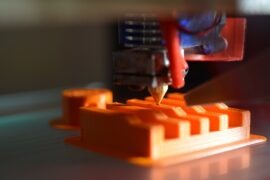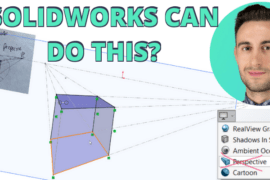While his day job has him designing engines for the Ford Motor Company (not a bad job in its own right), systems engineer Matt Schmotzer spends his free time creating 3D printed replicas of real-life roller coasters using his breadth of SOLIDWORKS knowledge and 3D printing techniques.
His first 3D printed roller coaster is a 1:25 scale replica of the Invertigo, an inverted boomerang roller coaster which propels its passengers upside down for the majority of the ride before propelling them back down the same track. He started working on the model in early 2017, using SOLIDWORKS to model the parts and print them in his garage.
As a one-time passenger of the stomach-churning roller coaster, making the Invertigo replica was a lot easier due to his ability to recreate the construction and scale from his own experience. Schmotzer simply took the layout for the coaster, exported the XYZ data onto an Excel spreadsheet, and scaled it down to fit his planned replica. Once the data was miniaturized, he exported it into SOLIDWORKS and designed the tracks, mechanisms, and launch station for the scaled model.

The biggest problem proved to be getting the carts to run on the tracks. Since the weight and dimensions of a real roller coaster cart are what allow it to run on the track, Schmotzer had to reduce the friction on the wheels and get the turns on the roller coaster just right so the cart completes its run without stopping or derailing from the track.
The friction problem was remedied by using ceramic bearings and a magnet-based lift system, while plastic tubing glued to the track helps keep the cart on the track. In total, the Invertigo replica is composed of 33 track sections and fits on a 4×8 foot table.

His success with the Invertigo 1:25 replica drew the attention of the SOLIDWORKS marketing crew, who got the talented engineer to showcase his 3D printed roller coaster at the 2019 SOLIDWORKS World Convention in Dallas, Texas in early February.
He was even able to collaborate with the Cedar Point Theme Park management on a static replica of their newest attraction: the Steel Vengeance. The life-sized coaster takes one of their older attractions, the Mean Streak, and combines wood and steel to create a more modern coaster with a 205-foot drop which gives riders 30 seconds of airtime.
Schmotzer’s replica of the Steel Vengeance, on the other hand, uses 3,500 printed parts integrated onto brass supports. Since he was working with Cedar Point, they were able to give him the blueprints for the ride.


His latest completed project is Batman: The Ride – a series of roller coasters based on the 1989 superhero film. Taking his experience from his Invertigo and static Steel Vengeance builds, Schmotzer used 10 3D printers and the SOLIDWORKS API to automate the track creation process—reducing the time it took to create the track to little over a month’s time.
Though the printing process took only 12 hours, Schmotzer had to splice the track sections together with the help of his wife. Using Microsoft Visual Studio, they created a series of macros to automate the splicing process. Instead of taking three weeks to hand-splice the tracks together (like he did with the Invertigo), the program now does the majority of the work automatically.
Schmotzer has tons more roller coaster replicas in the works. The Millenium Force roller coaster at Cedar Point has a replica in the works which is half finished, while another Cedar Point coaster called the Magnum XL-200 already has its design finalized and ready for printing (he must really love Cedar Point roller coasters). With more working replicas on the way, Matt Schmotzer could—using the words of Zoolander—open up his own miniature theme park for ants!





![6 Types of Civil Engineering Drawings [Detailed Guide]](https://www.solidsmack.com/wp-content/uploads/2023/12/Civil-Engineering-Drawings-270x180.jpeg)

